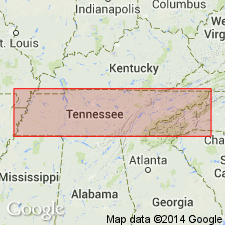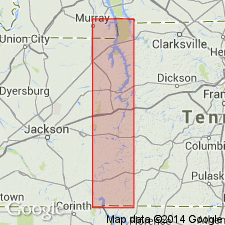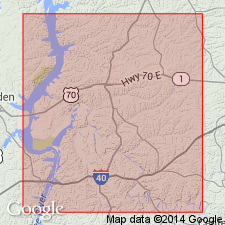
- Usage in publication:
-
- Ross formation
- Modifications:
-
- Named
- AAPG geologic province:
-
- Cincinnati arch
Summary:
Ross formation, here defined to include all beds overlying Decatur limestone and underlying Flat Gap or Harriman formations, includes Birdsong shale member, Bear Branch facies, Ross limestone member, Rockhouse shale and limestone members, Decaturville zone, and Bryozoan zone. Author believes that original separation of Pyburn from Ross was not justified, hence name Pyburn limestone is discontinued and all limestone formerly classed as Pyburn is included in Ross limestone member of Ross formation. Ross limestone member, as used here, would be represented at all localities mentioned in preceding work of Foerste, Dunbar, Miser, and Jewell. Ross member conformably overlies Rockhouse shale member in areas along Tennessee River and Horse Creek to south and overlies Rockhouse limestone member in outliers in Hardin and Wayne Cos.; member (and its local Bear Branch facies) unconformably underlies Flat Gap limestone or Harriman formation; northward Ross member grades into Birdsong shale member. Thickness of Ross member in northern part of outcrop area 35 to 45 ft; thickens southward to about 60 ft at Chalybeate Spring and 90 ft along Dry Creek. Cooper and others (1942, GSA Bull, v. 53, no. 12, pt. 1, chart 4) placed Rockhouse in the Silurian leaving Ross the oldest unit of Devonian. No reasons were given for this shift in classification, but presumably it resulted from recent analysis of fauna of Rockhouse. However, if Rockhouse is Silurian then entire Ross formation, including Ross limestone member and Birdsong shale member, are likewise Silurian. In one respect, such a shift would clear up matter of occurrence of unique bulbs of CAMAROCRINUS in a Niagaran formation and in a Devonian formation. Proposed change would limit range of these fossils to the Silurian.
Source: GNU records (USGS DDS-6; Reston GNULEX).

- Usage in publication:
-
- Ross Formation
- Modifications:
-
- Overview
- AAPG geologic province:
-
- Cincinnati arch
Summary:
Unit is predominantly Early Devonian, but base is younger (Early Devonian) to north than to south (Late Silurian). Subdivided into five laterally and vertically intergrading units (ascending): Rockhouse Limestone Member (north) and Rockhouse Shale Member (south); Birdsong Shale Member (north) and Ross Limestone Member (south); and Bear Branch Limestone Member (south). Stratigraphic interpretation is based on Wilson (1949). Overlies Decatur Limestone. Age based on conodonts.
Source: GNU records (USGS DDS-6; Reston GNULEX).

- Usage in publication:
-
- Ross Formation*
- Modifications:
-
- Biostratigraphic dating
- AAPG geologic province:
-
- Cincinnati arch
Summary:
In du Pont Geohydrological Survey well near Waverly, Humphreys Co., central TN, Ross Formation includes Rockhouse Limestone Member and Birdsong Shale Member; overlies Decatur Limestone. ICRIODUS WOSCHMIDTI? occurs in three samples (507.5 to 518.8 ft) from uppermost underlying Decatur and overlying Rockhouse. I. WOSCHMIDTI is considered an auxiliary guide to the base of the Devonian. These beds are assigned to WOSCHMIDTI Zone as the nominate species appears to restricted to its zone. Uppermost Decatur and Rockhouse are assigned an earliest Lochkovian age. The remainder of the Ross (its Birdsong Shale Member) and overlying Flat Gap Formation and Camden Formation are assigned a Lochkovian to Pragian age. [See articles by Broadhead and Gibson in this volume for excellent overviews of Ross Formation, its members, and adjacent units.]
Source: GNU records (USGS DDS-6; Reston GNULEX).
For more information, please contact Nancy Stamm, Geologic Names Committee Secretary.
Asterisk (*) indicates published by U.S. Geological Survey authors.
"No current usage" (†) implies that a name has been abandoned or has fallen into disuse. Former usage and, if known, replacement name given in parentheses ( ).
Slash (/) indicates name conflicts with nomenclatural guidelines (CSN, 1933; ACSN, 1961, 1970; NACSN, 1983, 2005, 2021). May be explained within brackets ([ ]).

